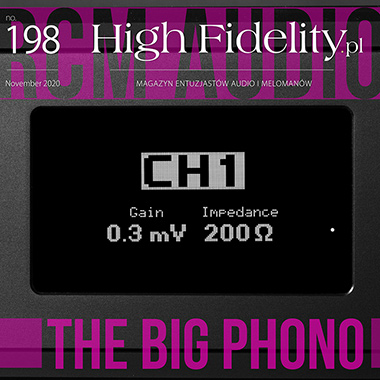No. 257 October 2025
- COVER REVIEW: ANCIENT AUDIO Silver Grand Mono Mk II ⸜ power amplifier • monoblocks » POLAND • Kraków
- KRAKOW SONIC SOCIETY № 153: 30 years of ANCIENT AUDIO » POLAND • Kraków
- FEATURE ⸜ music & technology: HISAO NATSUME presents - In search for the lost great pianism Chopin tradition » part 2 (France) » JAPAN • Tokyo
- REVIEW: AUDIOPHONIQUE Classic AP 300D ⸜ power amplifier » POLAND • Pruszków
- REVIEW: AVATAR AUDIO Holophony No. 1 ⸜ loudspeakers • floor-standing » POLAND • Osowicze
- REVIEW: DIVALDI Gold PA One ⸜ integrated amplifier » POLAND • Kraków
- REVIEW: J.SIKORA Aspire ⸜ turntable (deck + tonearm) » POLAND • Lublin
- REVIEW: MB AUDIO CABLE Silver ⸜ analog interconnect ⸜ RCA » POLAND • Turza Śląska
- REVIEW: XACT N1 ⸜ LAN switch » POLAND • Wrocław

|
Editorial
Text: WOJCIECH PACUŁA |
 |
No 198 November 1, 2020 |

It's hard not to agree with that - after all, the audio system itself is just a damn expensive collection of metal, electronic components, cables and god knows what else. It is the listener that gives it sense - a music lover, audiophile or - hopefully! - music lover / audiophile. This is a situation similar to literature or music - until there is some recipient, the written text (letters, notes) has only potential value, not a real one - it has not really existed yet. The condition of "to be or not to be" is an external observer. However, I have a problem with a description of the listening situation - it depends almost entirely on the listener and the conditions under which he / she is listening. Let's think what a classic listening to music session looks like. And by listening I mean critical and analytical listening to the music, aimed at determining the sound quality of a recording, a component of an audio system, or both. The classic listening process is such that one sits on an armchair, chair, sofa, etc., turn on the music and analyze the sound, using tools one is accustomed to though years of reading audio magazines and our one’s own experience . As a result of listening, we become richer with this experience and add it to the previous ones, building cumulative knowledge, i.e. one in which individual stages help each other, resulting in something more than a simple sum of the elements. So we are dealing with exactly the same case as in the case of an audio system which, when well tuned and matched, sounds better than each of its components listened to randomly. A well-chosen audio system can be described with a simple equation: 1 + 1 + 1 = 4 (sometimes, with a bit of luck - even more). However, while the components of the system in question are predictable, the listener is the unknown factor. From all the variables that make him/her up, it is possible to extract a "quantifiable" element, and thus the element which can be subjected to critical analysis - the SEAT. | Forming one’s surrounding I don't know if you paid attention to it, but each of the audio journalists who took part in the interviews for the series "The Editors" is sitting on something else (I think about what is BELOW them when they are listening :)). CAROL and DAVE CLARK, the editors of the Positive Feedback have a relatively low leather couch, as does PANAGIOTIS KARAVITIS from PART-TIME AUDIOPHILE magazine, which sits on a couch finished with a soft fabric. 
⸤ ERIK TECH in his chair On the other hand, ERIK TEH, the editor-in-chief of the ERIC'S HI-FI BLOG sits on a comfortable, padded, also quite soft armchair. MICHAEL LAVORGNA, editor-in-chief of the AUDIOSTREAM sits on a hard chair. And even further down this road went the editor-in-chief of the PART-TIME AUDIOPHILE, SCOT HULL, who posted his photograph in an expensive, specialized Lobster armchair by GamuT. There is a clear division among the editors - between those who have stiff, often even specialized armchairs or chairs that shape the posture of a seated person, and those who sit on soft sofas. Let me suggest a nomenclature for this division: the former would support TERRAFORMING, while the latter would favor PANTROPY. 
⸤ Panoramic photo of the listening room of PANAGIOTISAKARAVITIS from the Part-Time Audiophile Let's reach for an explanation and do it pop-culture style:
I'm referring to the Michael Chabon’s novel because it blends in nicely with what we're talking about - it's about a failing used vinyl store. The analogy seems clear to me - either we change the listening conditions to adopt them to our needs, using sophisticated seats, or we adapt to the existing conditions - for example, sitting on a sofa, which serves the whole family and guests. The distinction is not unambiguous, of course, but you know what I where I’m going with this. | What’s worth considering to sit on Both methods have advantages and disadvantages, although it must be admitted that terraforming is a better method from the audio test methodology point of view. Therefore, let's take a look at some of the most common solutions in this group, the chairs for listening to music. |1| EAMES Lounge Chair & Ottoman Both methods have advantages and disadvantages, although it must be admitted that terraforming is a better method from the audio test methodology point of view. Therefore, let's take a look at some of the most common solutions in this group, the chairs for listening to music. 
⸤ Mr. NINGSHENG LIU from Synergy HiFi and Create Audio, who once visited Krakow Sonic Society, sits on the Lounge Chair; in front of him an Ottoman footrest |
Rysiek S., one of the members of the Krakow Sonic Society, has Eames, so I have some experience with listening to music sitting on it (more HERE). The chair is effective, quite comfortable, but not very suitable for critical listening because it is tilted back and you sit in it quite low. It is, however, extremely good looking. 
⸤ Advertisement for Sennheiser with Le Corbusier Chaise Lounge Pad | photo: press release By the way - Sennheiser used another iconic product in their Orpheus headphone system ads, the Le Corbusier Chaise Lounge Pad, which would make sense because you can listen to the headphones while laying back. |2| GAMUT Lobster Lobster is an armchair produced by GamuT an audio company based in Denmark. Its designers were famous Danish designers - Lund & Paarmann - and they were made by the high-end furniture factory Kvist. Its modern version has been positively evaluated by many audio reviewers, including the aforementioned Scot Hull, joined in praise by Jeff Dorgay, the publisher of the "Tone" magazine (formerly "ToneAUDIO"; an interview with Jeff HERE). 
⸤ GamuT Lobster Hi-Fi Chair | photo: press release It is an armchair with a rigid shell made of bent plywood, it also has a steel base and leather upholstery, reminiscent of the Eames' Lounge Chair. Unlike the American design, the 95 cm high Lobster imposes a fairly straight seat, even though the seat is only 1 cm higher than in the Eames design. |3| KLUTZ DESIGN Balerina I do not know if you remember the Swedish company Klutz Design - this is a manufacturer that made our amazingly good looking headphone stands - CanCans). The company was founded in 2009 inspired by two designers - Cecilia Lütz and Michael Hollesen. Over the years, there were only two products in her portfolio: Cancans and the custom-made Ballerina; today there are also cable supports in the lineup. 
⸤ Klutz Design Balerina | photo: press release The Ballerina is a joint project of Jonas Rylander and Michael Hollesen, who is privately an audiophile. The armchair features a metal, chrome frame, a narrow headrest that always places it in the same place and does not interfere with listening. The armrests are hollow so that one can hide remote controls in them. As the designers said in 2010, when the prototype of the armchair was shown at the Audio Concept fair in Stockholm, it was a result of brainstorming about what is required of an audio armchair. And it turned out that we need: a headrest that is comfortable enough to allow long listening sessions, but not so big that it creates back reflections and interfered with the sound, a lower back than usual, but with good lumbar support, an adjustable height so that to match the angle of the tweeter and feet that help isolate the chair from vibration. |4| IKEA Äleby All the armchairs mentioned above are perfectly made, remarkable designs, so it's no wonder that they cost a lot of money. It is therefore worth paying attention to the armchair available for everyone, namely the Äleby model offered by the Swedish IKEA. 
⸤ IKEA Äleby | photo: press release It is a very nice, pleasant armchair upholstered in gray fabric. Its skeleton is made of bent eucalyptus plywood. Its height and lean angle are adjustable. The chair is 76 cm high, so it should not restrict reflections from the back of the head. | So who are you? So who are you? - More a member of the terraforming team, or do you find yourself more comfortable using a pantropic approach? I am in the latter group, although I look at the former with envy. However, before we start shopping, rearranging our living rooms, it is worth remembering that the most important thing in all this is the music and how WE want to listen to it. The rest is just a meaningless "blip". Even if it looks as insane as the armchairs mentioned above … ■ |
About Us |
We cooperate |
Patrons |
|
Our reviewers regularly contribute to “Enjoy the Music.com”, “Positive-Feedback.com”, “HiFiStatement.net” and “Hi-Fi Choice & Home Cinema. Edycja Polska” . "High Fidelity" is a monthly magazine dedicated to high quality sound. It has been published since May 1st, 2004. Up until October 2008, the magazine was called "High Fidelity OnLine", but since November 2008 it has been registered under the new title. "High Fidelity" is an online magazine, i.e. it is only published on the web. For the last few years it has been published both in Polish and in English. Thanks to our English section, the magazine has now a worldwide reach - statistics show that we have readers from almost every country in the world. Once a year, we prepare a printed edition of one of reviews published online. This unique, limited collector's edition is given to the visitors of the Audio Show in Warsaw, Poland, held in November of each year. For years, "High Fidelity" has been cooperating with other audio magazines, including “Enjoy the Music.com” and “Positive-Feedback.com” in the U.S. and “HiFiStatement.net” in Germany. Our reviews have also been published by “6moons.com”. You can contact any of our contributors by clicking his email address on our CONTACT page. |
 



|
   |
main page | archive | contact | kts
© 2009 HighFidelity, design by PikselStudio,
projektowanie stron www: Indecity







 reparing the 3-part mini-series entitled. MICROTUNNING I focused on three elements of audio systems: |1|
reparing the 3-part mini-series entitled. MICROTUNNING I focused on three elements of audio systems: |1| 



